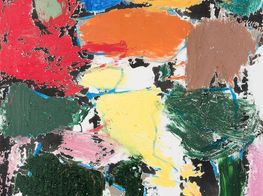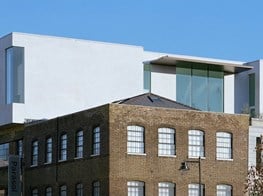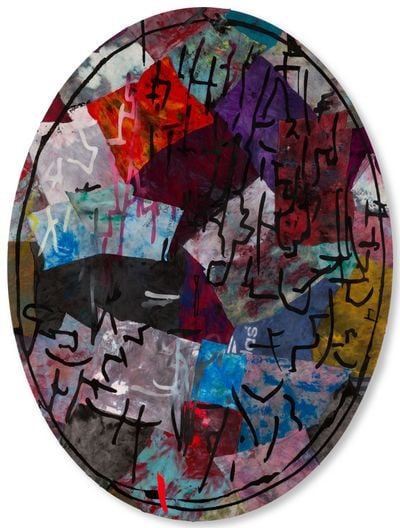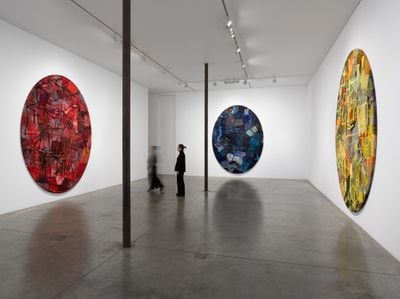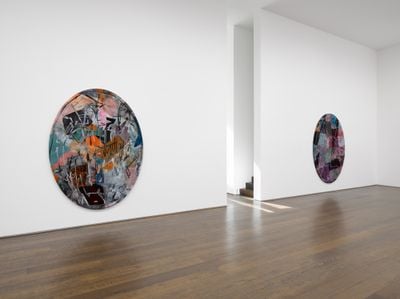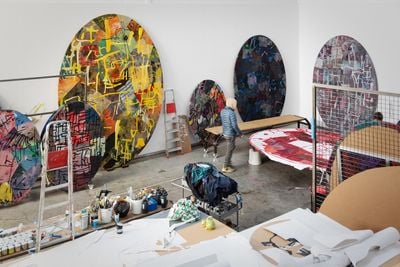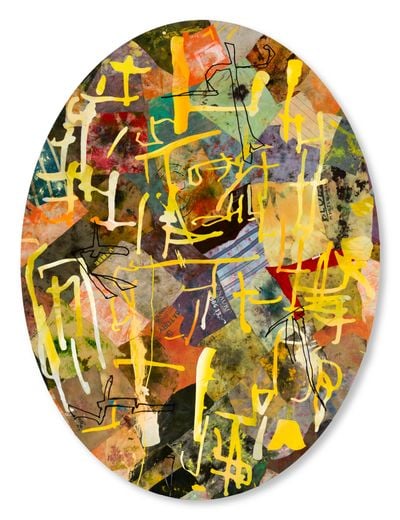
Secundino Hernández Rejects the Rectangle
Traditionally, painting has favoured rectangular canvases, a standard in Western art history. From Renaissance 'tondos' to abstract paintings in the 1960s framed on unconventional shapes like parallelograms, diamonds, or rhomboids, the shaped canvas has emerged as a way to disrupt aesthetic norms.
Secundino Hernández contributes to this discourse by rejecting the familiar rectangle in favour of oval-shaped canvases.
In his solo exhibition, Problematic Corners (10 April–18 May 2024), at Victoria Miro in London, the Spanish artist presents a series of new cornerless paintings. Bringing together bold hues, gestural lines, and mosaic-like patterns, Hernández introduces an exploration of space and form that stresses new challenges and alternate perspectives in painting.
Hernández shares insights into his affinity for the oval form, what inspires him most, and the unexpected parallels he discovered between winemaking at his Spanish vineyard and his creative process.
Tell me about your upbringing. Can you remember your first encounter with art?
For as long as I can remember, I've held pencils and paintbrushes. While other children played football, I spent my afternoons drawing. It wasn't until my parents enrolled me in drawing and painting classes that I saw a clear way to develop this interest.
I realised my only path was to fully dedicate myself to art, especially considering I wasn't a very good student in other subjects. That was the beginning of what you might call the 'first impulse'.
You have studios in Madrid and Berlin. What do you love about living in those cities?
I don't have a studio in Berlin anymore. However, I had arrived at a very exciting time. I learned a lot and made good friends. Although I'm still in touch with the city's arts scene, I wanted to establish a studio that incorporates the atelier, office, and archive—which is a huge project still in progress and Madrid was the right place to do that.
What do you do when you're not painting?
I'm developing a small vineyard in a village in Segovia, Fuentidueña, where I'm building a modest winery. Making wine and painting were among the first human activities in the course of civilisation. I've discovered that it connects me to rituals and deepens my understanding of the land, helping me to enjoy processes that also connect with my artistic interests.
What are your influences, artistic and other?
Rather than pinpointing specific influences, I'm more drawn to discussing the concerns and lines of research that guide my work.
Firstly, I'm interested in the procedural aspects of the artist's work—the research into materials, the processes, and the solutions born within the framework of the studio. Secondly, I'm interested in the historical dimension of the artwork, which implies research on the Old Masters and recurring themes throughout history.
Finally, I'm interested in discussing the intimate work of the painter, who turns to one of the earliest art forms to understand today's world, to map and connect it with shared states of mind.
Ultimately, I'm interested in delivering a work in which everyone can feel reflected and comforted. On this third line, I have reflected a lot over the last year.
The exhibition is a presentation of your oval works. What drove you to introduce this shape into your practice?
Why restrict ourselves to the rectangle or square? In many aspects of our lives, we've become accustomed to conventions, making us take notice when encountering a departure from the classical academic format. The oval shape offers various interpretations and meanings that are still relevant today. That's why it continues to attract me.
You've spoken about how the canvas is a playground to explore your relationship to the world and also a form of meditation. How does this show reflect your current outlook?
For me, painting is a tool for understanding the world, explaining my inner life, and forging connections with fellow human beings. It's a map and means of structuring my thoughts through colours, shapes, planes, and lines, both within empty and painted spaces.
In this sense, I experience painting as a phenomenon where the mental and the material converge. It's also a space where the work acts as a guide, elucidating aspects of life.
Could you elaborate on the concept of your 'endlessly generative process' in the context of the works featured in this exhibition?
In my view, the essential thing about art lies in the questions it raises rather than the formal or visual answers it can offer. Art has always been present in the great questions of humanity as a way of defining reality and contemplating the meaning of human activity.
Other disciplines can be visually similar, especially in these times of convergence, but I believe the essence of art lies in its capacity to raise questions.
In conversation with Ocula Magazine in 2015 you mentioned that you will always tell your galleries whether you need to paint five hundred paintings or five. It's about what you need. What was the mood going into this exhibition?
To be honest, this organisational aspect is managed by the different galleries I work with and is not something I'm very attentive to nowadays. My focus is centred on the work itself and its reception by individuals whose opinions I value.
These are matters that can attract a lot of attention and lead to a big audience, but they also give little contrast or exaggerated information that doesn't necessarily contribute to a better understanding of the work itself—which, at the end of the day, is what's most important.
What part of the painting process do you find most rewarding?
I believe that both my style and painting process are recognisable. Achieving this recognition has been rewarding because behind it are hours of work and research.
My work features idiosyncratic elements, like the 'palette paintings' where I experiment with combining calligraphic strokes and large masses of colour, or the 'wash paintings', where I investigate the dialectic between the act of painting and that of erasure.
However, I believe an artist must redefine their own visual and discursive territory as the work develops.
Is painting intuitive to you?
Beyond the lines of research I've already mentioned, I elaborate on each painting with sincerity. My aim is to bring it to resolution in the most suitable, balanced, and adequate way, to reach its potential.
It's not easy to explain; there's a point you reach where there is something inside you telling you what to do on the canvas, and the process of painting becomes purely intuitive.
Alongside Victoria Miro, you work with a number of other galleries—namely, Galerie Forsblom (Helsinki), Galerie Krinzinger (Vienna), Galerie Bärbel Grässlin (Frankfurt), and Galería Ehrhardt Flórez (Madrid)—a shift from the traditional artist-gallery power, which we've increasingly seen, notoriously with Alvaro Barrington. At what point does collaboration with others begin for you?
I believe that collaborations can have a profoundly positive impact, particularly if the aim is to promote the artist by fostering both their work and personal growth.
In 2017, I was offered the opportunity to participate in Art Basel Unlimited, which involved Victoria Miro, Galerie Bärbel Grässlin, and Galerie Krinzinger. This collaboration gave me a platform to present a particularly challenging work at the time.
In a rapidly changing world, I believe that new ways of joining forces offer great ways to collectively evolve.
What's next?
Recently, I presented a series of silkscreen works at Galería Ehrhardt Flórez, followed by an exhibition of new paintings at Galerie Krinzinger. I also had my first exhibition at Nino Mier Gallery in Los Angeles.
Currently, I'm preparing for my debut exhibition at Skarstedt Gallery in New York, followed by institutional projects such as Sala Alcalá 31 in Madrid. —[O]
Main image: Secundino Hernández Studio, Madrid (2024). © Secundino Hernández Studio. Courtesy the artist and Victoria Miro. Photo: Rafael Trapiello.

